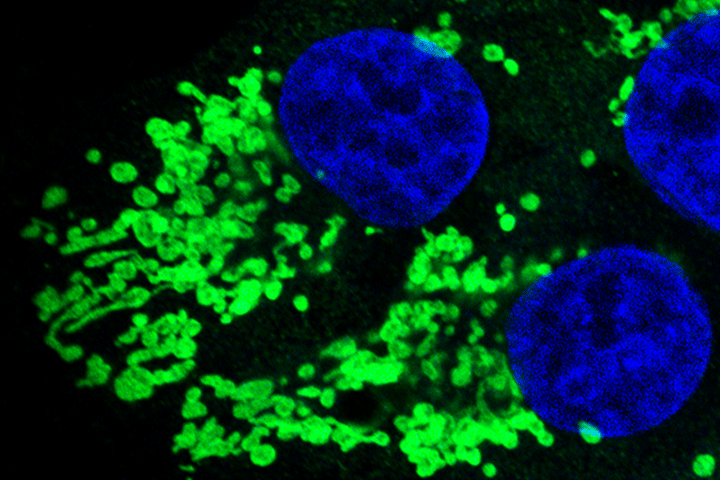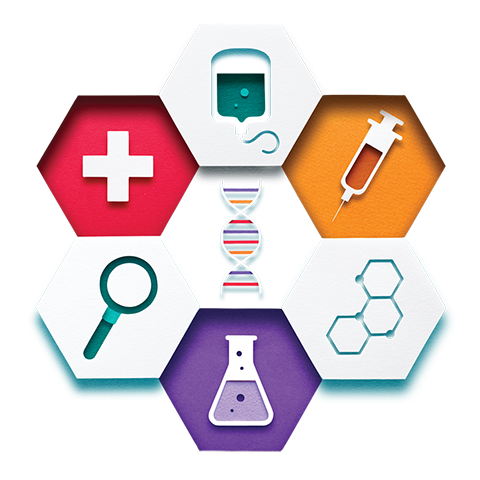Highlights from the 2025 AACR Annual Meeting

David Kashatus; National Cancer Institute / Univ. of Virginia Cancer Center
An important part of the scientific method is the sharing of data.
This collaborative effort among scientists advances knowledge, encourages transparency, and helps to validate research. Most importantly, collaboration allows scientists to build upon existing work, potentially leading to new discoveries that could result in earlier detection of disease, interception of disease, better diagnostics, and ultimately, better treatments.
Fundamental Research Leads to Potential New Treatments
The sharing of data and ideas was the central focus of the American Association of Cancer Research (AACR) Annual Meeting 2025. Held in Chicago from April 25th to the 30th, the meeting brought together more than 20,000 cancer experts and industry leaders from around the world to learn about the fundamental research being conducted. This year’s theme was “Unifying Cancer Science and Medicine: A Continuum of Innovation for Impact.” Although this meeting addresses all cancers, pancreatic cancer was well-represented. Here are just a few of the highlights from the 2025 meeting. (Let’s Win will cover some of these highlights in greater detail in the coming months.)
KRAS Inhibition Takes Center Stage
KRAS mutations, found in up to 90 percent of pancreatic cancer patients, were once considered “undruggable” treatment targets, but continuing research has resulted in new therapies. The first drug, sotorasib, was approved in 2021 for treating non-small cell lung cancer with the KRAS G12C mutation, opening new avenues for treating other KRAS mutations in lung, pancreatic, and colorectal cancers. Today, both sotorasib and another KRAS inhibitor called adagrasib are treatment options for people with unresectable pancreatic cancer with the KRAS G12C mutation. These drugs are usually considered only after pancreatic cancer has not responded well to or worsened after receiving another type of treatment.
The 2025 AACR Annual Meeting featured several presentations and discussions on KRAS, including oral investigational agents like daraxonrasib (RMC-6236) and vaccines for pancreatic cancer and other solid tumors. Discussions also highlighted the importance of addressing KRAS resistance and the development of RAS(ON) therapies, a class of cancer treatments that specifically target the active, or “on,” state of the RAS protein in cells.
Targeting Resistance to RAS Inhibition in Pancreatic Cancer
Andrew Aguirre, M.D., of the Dana-Farber Cancer Institute in Boston, Massachusetts, highlighted the work being done in trying to overcome the eventual resistance pancreatic cancer patients develop when treated with RAS inhibitors. Today, there are some 50 RAS inhibitors being tested in clinical trials. For example, drugs that inhibit KRAS G12C are showing impressive response rates of 20 to 40 percent and disease control rates of 80 to 90 percent. However, resistance remains a hurdle.
Researchers are looking for genetic and non-genetic pathways that control resistance. Mutations present in different cancers have been found to contribute to resistance. For example, Aguirre’s research, supported in part by the Lustgarten Foundation, recently revealed how pancreatic cancer cells change to evade RAS inhibitors—by morphing into cells that no longer rely on RAS to grow.
Pan-RAS Inhibition
The new agent daraxonrasib (RMC-6236), a pan-RAS inhibitor developed by Revolution Medicines, is showing some promise in treating pancreatic cancer. The drug is a RAS(ON) multi-selective inhibitor with the potential to help address a wide range of cancers driven by oncogenic RAS mutations. Daraxonrasib suppresses RAS signaling by blocking the interaction of RAS(ON) with its downstream effectors. It does so across oncogenic RAS mutations G12X, G13X, and Q61X in cancers including pancreatic, non-small cell lung, and colorectal. Let’s Win will be providing more information on the phase III RASolute trial of this potentially important drug.
Vaccine Targets Six KRAS Mutations in High-Risk Patients
New developments in KRAS-targeted vaccine-based immunotherapies were presented by Elizabeth Jaffee, M.D., of Johns Hopkins Sidney Kimmel Comprehensive Cancer Center in Baltimore, Maryland. In work partly funded by the Lustgarten Foundation, Jaffee and her team are developing a vaccine that covers all six common KRAS mutations in pancreatic cancer: KRAS G12D, G12R, G12V, G12A, G12C, and G13D. The vaccine uses long peptide sequences corresponding to these KRAS subtypes. It presents the immune system with a small piece of the mutated KRAS protein, triggering a specific immune response that recognizes and attacks the mutated protein.
The vaccine is being tested in clinical trials to evaluate its safety and efficacy. It holds promise for preventing pancreatic cancer in high-risk individuals by training their immune system to recognize and destroy cancer cells expressing the mutated KRAS protein. In early work, researchers are seeing a robust immune response to the vaccines that still remains one year post vaccination.
A New Approach to Detection and Treatment
Radiotheranostics combines molecular imaging and targeted radionuclide therapy. It uses radiolabeled probes to target specific disease cells like cancer, allowing for both imaging and treatment. It is already in use with radioiodine for thyroid diseases, peptide receptor radionuclide therapy (PRRT) for neuroendocrine tumors, and prostate-specific membrane antigen (PSMA) targeting in prostate cancer treatment. Now this precise and powerful approach, funded in part by the Lustgarten Foundation, is being investigated in pancreatic adenocarcinoma.
Julie Sutcliffe, Ph.D., of UCDavis Health (Sacramento, California), and her team performed a first-in-human study to evaluate the safety of the theranostic peptide pair gallium-68 (Ga-68) DOTA-5G (imaging tracer) and lutetium-177 (Lu-177) DOTA-ABM-5G (radiotherapeutic) in patients with locally advanced or metastatic pancreatic cancer.
Trial results show that among 36 patients imaged and 23 patients treated there were no severe adverse events and radiation exposure was safe. Using this approach, the investigators were able to “see” metastases in the liver, lung, bone, and brain that were too small to be seen by other methods. Although this early trial was primarily focused on safety, the researchers got a signal there is some potential loss of uptake—meaning fewer tumor cells—in some patients who underwent repeat imaging. Work will be ongoing and will also extend to non-small cell lung cancer, metastatic carcinomas, and lobular breast cancer. The researchers hope to move into multi-dosing approaches, the use of other isotopes, and combination approaches in further research.
AI Provides an Assist with Cachexia Detection
Cachexia, also known as wasting syndrome, is a complex metabolic condition characterized by significant weight loss, muscle wasting, and fatigue. About 80 percent of pancreatic cancer patients experience this devastating condition, which affects both the physical and psychological well-being of patients and their families. This debilitating complication is often caught late, and leads to an estimated 30 percent of overall cancer deaths.
Researchers from the Moffitt Cancer Center in Tampa, Florida, have developed a new, multimodal AI-driven biomarker model that integrates data from routinely-collected imaging scans, lab tests, and clinical notes to compute the probability that a patient has or will develop cancer cachexia. Standard methods to detect cancer cachexia can be subjective and inconsistent, but the multimodal AI-driven biomarker model identified cancer cachexia in pancreatic cancer patients with 85 percent accuracy.







